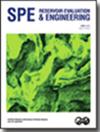储层模拟中多尺度非均质性表征的特殊联系
IF 1.5
4区 工程技术
Q3 ENERGY & FUELS
引用次数: 0
摘要
巴西盐下油田裂缝性岩溶储层中含有大量石油,这给开发升级程序以减少数值模拟时间带来了新的挑战。这项工作旨在基于基质、岩溶和裂缝介质之间的特殊联系来表示油藏模拟器中的多尺度非均质性,这两种介质都在单一孔隙流动模型的不同网格域中建模。这种表示的目的是在精度和仿真时间之间取得良好的平衡。因此,本工作扩展了Correia等人(2019)开发的特殊连接方法,以整合在不同网格域和块尺度上建模的岩溶和裂缝介质。三个区域之间的传递率计算是基于两点通量近似格式的常规公式和基质-裂缝流体传递公式的结合。每个区域内的流动由达西方程控制,并由模拟器隐式求解。为了适当的验证和数值验证,我们将该方法应用于一个简单的情况(两相和三相流)和一个真实的情况(两相流)。对于简单情况,参考模型是一个精细的网格模型,其中:(1)大型管道(岩溶)排列,连接不良;(2)连通良好的正交裂缝体系;(3)背景介质(矩阵)。实际案例是巴西盐下油田的一段,其特点是天然裂缝型碳酸盐岩储层。参考是地质模型。模拟模型由一个根据非均质尺度不同网格块大小的结构模型组成——小尺度岩溶几何形状、中等尺度基质性质和大尺度裂缝特征,通过特殊连接相互连接。两种情况下的结果都表明,在不使用非结构化网格的情况下,在适当的模拟时间内与参考模型的动态匹配响应以及根据具有代表性的异质性基本体积保持动态分辨率方面,性能有了显着提高。与参考模型相比,简单案例和真实案例的仿真时间分别缩短了42%和87%。该方法在保持小尺度非均质性高分辨率的同时,提供了一种多尺度流动模拟解决方案,可以使用结构化网格来管理非均质地质场景,并提供了精度与模拟时间之间的良好关系。本文章由计算机程序翻译,如有差异,请以英文原文为准。
Special Connections for Representing Multiscale Heterogeneities in Reservoir Simulation
Summary The significant quantities of oil contained in fractured karst reservoirs in Brazilian presalt fields add new challenges to the development of upscaling procedures to reduce time on numerical simulations. This work aims to represent multiscale heterogeneities in reservoir simulators based on special connections between matrix, karst, and fracture mediums, both modeled in different grid domains within a single porosity flow model. The objective of this representation is to strike a good balance between accuracy and simulation time. Therefore, this work extends the approach of special connections developed by Correia et al. (2019) to integrate both karst and fracture mediums modeled in different grid domains and block scales. The transmissibility calculation between the three domains is a combination of the conventional formulation based on two-point flux approximation schemes and the matrix-fracture fluid transfer formulation. The flow inside each domain is governed by Darcy’s equation and implicitly solved by the simulator. For proper validation and numerical verification, we applied the methodology to a simple case (two-phase and three-phase flow) and a real case (two-phase flow). For the simple case, the reference model is a refined grid model with (1) an arrangement of large conduits (karsts), which are poorly connected; (2) a well-connected and orthogonal system of fractures; and (3) a background medium (matrix). The real case is a section of a Brazilian presalt field, characterized as a naturally fractured carbonate reservoir. The reference is the geological model. The simulation model consists of a structural model with different gridblock sizes according to the scale of the heterogeneities—small-scale karst geometries, medium-scale matrix properties, and larger-scale fracture features—interconnected by special connections. The results for both cases show a significant performance improvement regarding a dynamic matching response with the reference model, within a suitable simulation time and maintaining the dynamic resolution according to the representative elementary volume of heterogeneities, without using an unstructured grid. In comparison to the reference model, for the simple case and the real case, the simulation time was reduced by 42% and 87%, respectively. The proposed method contributes to a multiscale flow simulation solution to manage heterogeneous geological scenarios using structured grids while preserving the high resolution of small-scale heterogeneities and providing a good relationship between accuracy and simulation time.
求助全文
通过发布文献求助,成功后即可免费获取论文全文。
去求助
来源期刊
CiteScore
5.30
自引率
0.00%
发文量
68
审稿时长
12 months
期刊介绍:
Covers the application of a wide range of topics, including reservoir characterization, geology and geophysics, core analysis, well logging, well testing, reservoir management, enhanced oil recovery, fluid mechanics, performance prediction, reservoir simulation, digital energy, uncertainty/risk assessment, information management, resource and reserve evaluation, portfolio/asset management, project valuation, and petroleum economics.

 求助内容:
求助内容: 应助结果提醒方式:
应助结果提醒方式:


